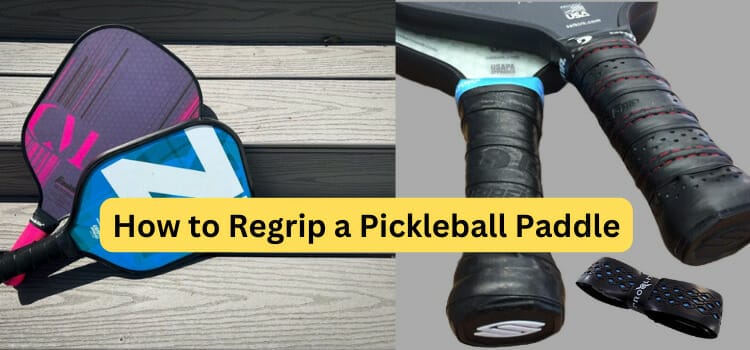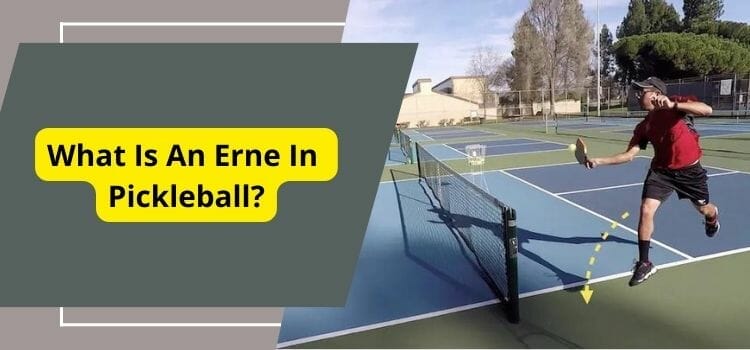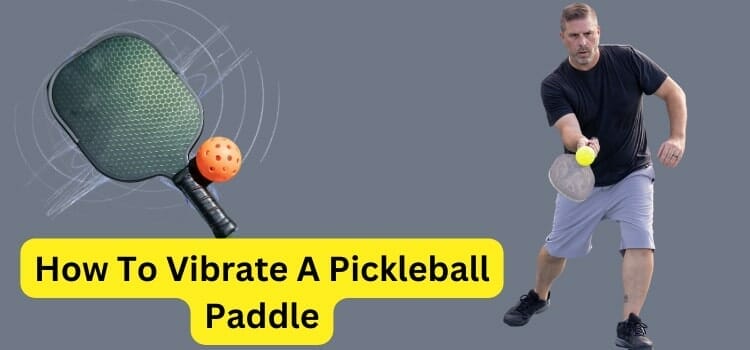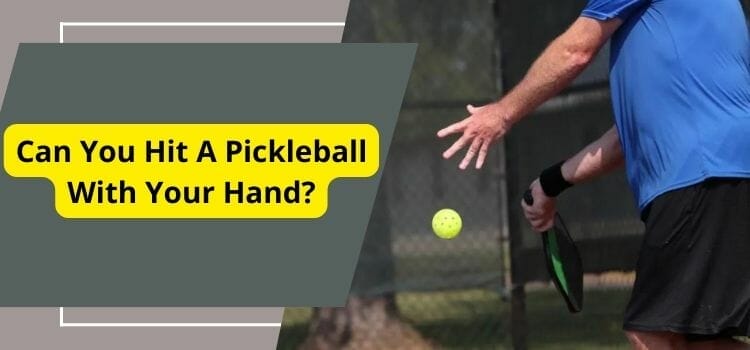How to Regrip a Pickleball Paddle: Complete Guide

Are you ready to take your pickleball game to the next level? One simple yet often overlooked way to improve your performance is by having a proper grip on your paddle. Whether you’re a seasoned pro or just getting started, understanding how to regrip a pickleball paddle can make all the difference in your gameplay.
To regrip a pickleball paddle, start by removing the old grip carefully. Clean the handle to remove residue and prepare it for the new grip. Apply adhesive as needed and wrap the new grip tightly from one end to the other. Trim any excess material here with the following step-by-step guide on how to regrip a pickleball paddle.
Here we’ll walk you through the step-by-step process of regripping your paddle and provide valuable tips and tricks, tools, and materials, along the way. So grab your paddle and let’s dive into this ultimate guide on how to give it a fresh new grip!
Tools and Materials Needed
When it comes to regripping your pickleball racquet, having the right tools and materials is essential. Here’s a list of what you’ll need to successfully complete the process.
1. Replacement Grip or Overgrip: Depending on your preference, you can choose between a replacement grip or an overgrip. The replacement grip provides a more permanent solution, while the overgrip is easier to apply and replace when needed.
2. Scissors: You’ll need a pair of scissors to cut off the old grip before applying the new one. Make sure they are sharp enough for clean cuts.
3. Solvent: A solvent such as rubbing alcohol or grip solvent will help remove any residue from the previous grip and ensure proper adhesion of the new one.
4. Clean Cloth: Use a clean cloth or paper towel to wipe down the paddle handle with solvent and remove any dirt or debris.
5. Grip Tape: If you’re using an overgrip, make sure you have enough tape to secure it in place once applied.
6. Gripping Cone: A gripping cone can be helpful in sliding on tight-fitting replacement grips without wrinkles or air bubbles.
Having these tools and materials ready before starting will make the regripping process much smoother and more efficient. So gather everything together, follow our step-by-step guide, and get ready to improve your game with a fresh new grip!
How to Regrip a Pickleball Paddle: Step-by-Step Guide
Step 1: Remove the old grip
Start by carefully removing the old grip from your pickleball paddle. Use a knife or scissors to cut through the grip and peel it off. Take your time to avoid damaging the underlying handle.
Step 2: Clean the handle
Once you have removed the old grip, take a damp cloth and clean any residue left on the handle. Make sure it is dry before proceeding to the next step.
Step 3: Prepare the new grip
Unroll your replacement grip and check if it needs to be stretched or prepped in any way according to manufacturer instructions. This will ensure that it fits properly on your paddle’s handle.
Step 4: Apply adhesive (if necessary)
Some grips come with an adhesive backing, while others require you to apply glue or tape. Follow the specific instructions for your chosen grip and make sure to evenly distribute adhesive along the length of your paddle handle.
Step 5: Start wrapping
Begin at one end of your paddle’s handle and start wrapping tightly with smooth, overlapping motions towards the other end. Keep tension on the grip as you go but be careful not to pull too hard, as this can cause stretching or tearing.
Step 6: Trim excess
Once you have reached the end of your paddle’s handle, trim any excess material using sharp scissors or a knife. Be precise when cutting so that there are no loose ends sticking out.
Your pickleball paddle has been successfully regripped! Now you can enjoy improved control and comfort during gameplay. Remember, proper maintenance is crucial for longevity, so regularly clean and inspect your newly gripped paddle for optimal performance on the court.
Importance of a good grip on a pickleball paddle
When it comes to playing pickleball, having a good grip on your paddle is absolutely crucial. The grip is the only point of contact between you and the paddle, so it directly affects your control, power, and overall performance on the court.
A proper grip allows you to maintain control over your shots. Without a secure hold on the handle, your paddle can slip out of your hand during fast-paced rallies or intense serves. This not only leads to missed shots but also poses safety concerns for both yourself and other players.
An effective grip enhances power in your swings. A firm grasp enables you to transfer more energy from your body into each shot, resulting in stronger hits that are harder for opponents to return. It gives you the confidence needed to put extra spin or pace into your shots without worrying about losing control.
A comfortable grip minimizes fatigue during long matches or practice sessions. If your hands start cramping or slipping due to an inadequate grip, it becomes difficult to execute precise shots consistently. By using grips that provide cushioning and sweat absorption properties, you can play comfortably for longer periods without compromising performance.
Don’t underestimate the impact of a good grip when it comes to improving your game in pickleball! It’s worth investing time in choosing the right type of grip for your playing style and regularly replacing worn-out grips for optimal performance on the court!
Why Change the Pickleball Paddle Grip?
Having a good grip on your pickleball paddle is crucial for optimal performance on the court. Over time, however, the grip can wear down, become slick or lose its tackiness. This can greatly impact your ability to control the ball and execute shots with precision.
- One reason to change your pickleball racket grip is to maintain consistent control and feel during gameplay. A worn-out or deteriorated grip can cause your hand to slip while swinging, leading to missed shots or even injury.
- Consider changing your blade grip as a personal preference. Different players have different preferences when it comes to the thickness and texture of their grips. Changing the grip allows you to customize it according to what feels most comfortable and natural in your hand.
- An updated grip can provide better shock absorption, reducing strain on your arm and wrist during intense rallies. This can help prevent injuries such as tennis elbow or tendonitis.
Remember: Grips are not one-size-fits-all! Experiment with different grips until you find one that suits both your playing style and personal comfort preferences.
When to Re-Grip Your Paddle
Knowing when to re-grip your pickleball paddle is essential for maintaining optimal performance on the court. Here are some indicators that it’s time to re-grip your paddle:
Remember, the frequency of re-gripping your paddle will depend on factors such as usage, playing conditions, and personal preference. It’s a good practice to inspect your grip regularly and regrip when necessary to maintain optimal performance and comfort during your pickleball games.
What’s the difference between a replacement grip and the “overgrip”?
When regripping your pickleball paddle, you’ll encounter two terms: replacement grip and overgrip. A replacement grip is a thicker grip applied directly to the handle, providing a new base layer. An overgrip is a thinner grip applied over an existing grip for added comfort and performance. there are some key differences between the two.
A replacement grip is a full-length, cushioned grip that covers the entire handle of your pickleball racket. Made of materials like synthetic or natural leather, it provides a fresh surface with enhanced shock absorption. Thicker than overgrips, replacement grips offer improved comfort and grip control.
An overgrip is a thin layer that is applied over an existing grip, whether it’s the factory-installed grip or a previously applied replacement grip. Made from tacky materials like rubber or cloth, overgrips offer added traction without altering the size or feel of the handle. They are easy to install and don’t require removing any existing grips.
Choose a replacement grip for a completely new feel and added cushioning, or an overgrip to enhance your current grip without altering its size significantly. The decision depends on personal preference.
What is the best grip for a pickleball paddle?
When it comes to choosing the best grip for your pickleball paddle, Choose a grip that prioritizes comfort, moisture absorption, and gripping power to enhance your performance in pickleball. Experiment with different options to find the perfect grip that suits your preferences and playing style. there are a few factors to consider.
One popular option is a cushioned grip, which provides extra padding for added comfort and reduces vibration upon impact. This can be especially beneficial if you have joint issues or prefer a softer feel.
Consideration is moisture absorption. Pickleball can be an intense and sweaty sport, so having a grip that effectively absorbs sweat can make all the difference in maintaining a secure hold on your paddle.
Some players also opt for tacky grips, which provide enhanced gripping power by creating friction between the palm of your hand and the surface of the grip. This can help improve accuracy and prevent slipping during gameplay.
Finding the perfect grip depends on personal preference and playing style. Invest in a high-quality grip to maximize your on-court performance.
Tips and Tricks for Successful Regripping
When regripping your pickleball paddle, take your time, gather the necessary tools, and remove the old grip carefully. Clean the handle before applying the new grip. Follow the manufacturer’s instructions for proper application, ensuring a smooth wrap without wrinkles. Secure the grip with adhesive tape and trim any excess material with caution.
There are a few tips and tricks that can help ensure a successful result.
- Before starting, ensure you have the essential tools and materials ready. this includes a replacement grip or overgrip, scissors, adhesive tape, and rubbing alcohol or grip solvent
- Start by removing any old grip from your pickleball racket carefully. Use a utility knife or razor blade to slice through it and peel it off gently. Once removed, clean the handle with rubbing alcohol or grip solvent to remove any residue left behind.
- Follow the manufacturer’s instructions on how to apply your chosen replacement grip or overgrip properly. Most grips will come with an adhesive backing that should be peeled away as you wrap it around the handle.
- Make sure it is smooth and free of wrinkles or bubbles that can cause discomfort while playing. Pull taut but not too tight so that you maintain control without sacrificing comfort.
- Use adhesive tape at both ends of the grip to secure it in place. This will prevent unraveling during gameplay.
By following these tips and tricks, you can successfully regrip
Maintaining a Gripped Pickleball Paddle
Once you’ve successfully regripped your pickleball paddle, it’s important to take proper care of the grip to ensure its longevity and effectiveness. Here are some tips for maintaining a gripped pickleball racquet.
Keep your paddle clean. After each game or practice session, wipe down the grip with a damp cloth to remove sweat and dirt that can accumulate on the surface. This will help prevent any buildup that could affect the texture and feel of the grip.
Avoid exposing your paddle to extreme temperatures or prolonged sunlight. Heat can cause the adhesive on the grip to deteriorate over time, while excessive exposure to sunlight can lead to fading or cracking of the grip material.
Protect your grip, consider using an overgrip as an additional layer of defense against wear and tear. Overgrips are designed specifically for this purpose and can be easily replaced when they start showing signs of wear.
Store your pickleball racket in a cool, dry place when not in use. Avoid storing it in areas where it may be subjected to moisture or humidity as this can damage both the racket itself and its grip.
By following these simple maintenance practices, you’ll be able to extend the life of your newly gripped pickleball paddle and continue enjoying optimal performance on the court!
Common Mistakes to Avoid During the Regripping a Pickleball Paddle Process
When it comes to regripping a pickleball racket, there are a few common mistakes that players should avoid to ensure a successful process. One mistake is not properly cleaning the paddle handle before applying the new grip. It’s important to remove any dirt, oil, or residue from the handle to ensure optimal adhesion of the upgraded grip.
Another mistake is not allowing enough time for the adhesive to dry and set properly. After applying the renewed grip, it’s crucial to follow the manufacturer’s instructions regarding drying time. Rushing this step can result in an unstable grip that may peel or shift during play.
Using too much or too little adhesive can also be problematic. Applying too much adhesive can create a messy and uneven grip, while using too little may result in inadequate adhesion and premature wear of the grip.
Improper alignment of the replacement grip is another common mistake. It’s important to carefully align and position the updated grip so that it covers the entire handle evenly without any wrinkles or creases.
By avoiding these common mistakes when regripping your pickleball paddle, you’ll be able to enjoy a secure and comfortable hold on your racket during every game.
Conclusion
Mastering how to regrip a pickleball paddle is not only about functionality but also about personal preference. By taking care of this important aspect of equipment maintenance, you can elevate your game to new heights! So grab those tools now and give yourself an edge on the court!
Regripping a pickleball paddle is an essential skill for any serious player. With the right tools and materials, you can easily replace your worn-out grip or enhance your paddle’s performance with a new one.
A solid grip on your pickleball paddle is essential for control and comfort during gameplay. Follow our step-by-step guide for successful regripping, avoiding mistakes like rushing or using too much adhesive. Prepare the surface properly to ensure optimal results.
How do you put a grip on a paddle?
To put a grip on a paddle, start by removing any old grip from the paddle handle. Clean the handle surface, and then prepare the new grip by unrolling and stretching it if necessary. Apply adhesive or peel off the backing on the grip, and wrap it tightly around the handle, ensuring a smooth and secure fit. Trim any excess material if needed.
Can you double-grip a pickleball paddle?
Yes, you can double-grip a pickleball paddle by adding an extra layer of grip on top of the existing grip. This is known as an overgrip and can provide added comfort and traction without significantly changing the size or feel of the handle.
What’s the difference between grip and overgrip?
A grip is a thicker grip that replaces the existing grip on the handle, while an overgrip is a thinner grip that is applied over the existing grip. The grip provides a new base layer, while the overgrip offers added comfort without changing the handle size significantly.
What is the proper pickleball grip size?
The proper pickleball grip size is subjective and depends on individual preference. It is recommended to choose a grip size that feels comfortable and allows for a secure hold on the paddle. Grip sizes typically range from 4 inches to 4.5 inches in circumference, but players may find variations within this range more suitable for their hand size and playing style.






